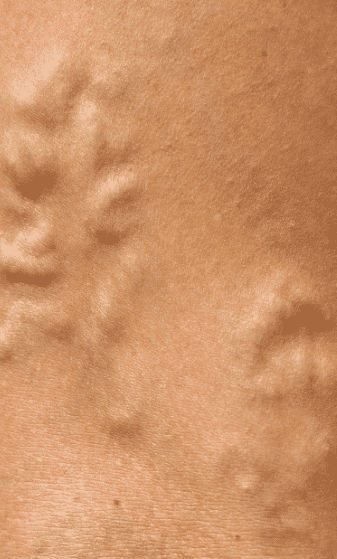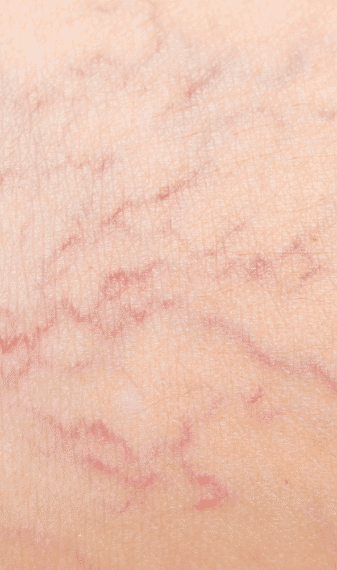What are Varicose Veins and Spider Veins?


Varicose Veins
Varicose veins are large, dilated blood vessels that bulge out of the skin’s surface on the legs. They may be blue, red, green, or purple, and they often resemble dense masses of knotted and tangled ropes. Genetic predisposition is the leading risk factor for varicose veins. Patients with a family history of vein problems have a high likelihood of suffering from varicose veins at some point.
Chronic venous insufficiency is the primary root cause of varicose veins. Venous insufficiency is a circulatory disorder wherein the weakening of vein valves makes blood flow backward and accumulate in the leg veins, eventually leading to vascular dilation and the formation of varicose veins. As such, varicose veins are essentially dilated veins with excessive blood.

Spider Veins
Spider veins, medically known as telangiectasias, are red, blue, or purple blood vessels that appear just underneath the skin’s surface in dense clusters. They’re called “spider veins” because they resemble spider webs expanding outwards from a central location.
Spider veins are also dilated veins with excessive blood. They’re often, but not always, caused by underlying chronic venous insufficiency, a condition wherein the collapse of vein valves makes blood accumulate in the leg veins. Spider veins aren’t dangerous in and of themselves, but the underlying vein disease can be dangerous.
Let us give you a Lifechanging Experience. Feel in love with your legs again!
BOOK AN APPOINTMENT NOW
Vein Disease Symptoms

Restless Legs Syndrome (RLS)
Chronic venous insufficiency is one of the most common root causes of restless legs syndrome, especially if your symptoms worsen at night or after long periods of sitting or standing still. The best way to treat restless legs syndrome is by treating the underlying chronic venous insufficiency. That’s why you must consult a reliable vein clinic in Long Island for a consultation.

Leg Cramps
Leg cramps are painful muscular contractions of the legs that occur in quick spasms, usually lasting for a few seconds or minutes. Leg cramps originating in the thighs or calves can often spread to other parts of the body, such as the arms.
Most people experience leg cramps occasionally due to extended periods of inactivity, dehydration, electrolyte imbalances, and other conditions. In these situations, drinking plenty of water and maintaining a balanced diet with magnesium and potassium should resolve the problem. However, if your leg cramps persist or if the frequency of leg cramps increases at night, you may have underlying chronic venous insufficiency and should consult a reliable vein clinic in Long Island promptly.

Leg Heaviness
Chronic venous insufficiency is the most common cause of leg heaviness, especially if the symptoms worsen at the end of the day or if they’re accompanied by other symptoms, such as spider veins and varicose veins. Leg heaviness caused by vein disease can be temporarily relieved with exercise. However, you must consult a vein doctor specializing in minimally invasive vein treatments for permanent relief.

Leg Swelling
Chronic venous insufficiency is the most likely cause of leg swelling if your symptoms worsen at the end of the day or after long periods of sitting or standing still. You can improve the symptoms by elevating your legs or exercising your leg muscles, but these techniques provide temporary relief. If you want long-lasting relief, please contact a vein doctor specializing in minimally invasive treatments for venous insufficiency.
Are you experiencing painful or uncomfortable vein disease symptoms?
All vein treatments in Long Island are covered by most health insurance, including medicare. Submit this form to verify coverage:
Causes of Vein Disease

Risk Factors for Vein Problems
Genetic predisposition is the leading risk factor for spider veins and varicose veins. If your mom and dad have a history of vein problems, there’s a strong chance you’ll eventually develop vein problems. Female hormones, such as estrogen, increase the risk of vein problems, which is why women (especially pregnant women) are more likely to get spider veins and varicose veins than men.
The risk of vein disease also depends on an individual’s occupation. If your job requires you to sit or stand still for extended periods, you’re more likely to get spider veins and varicose veins. That’s why vein problems are more common amongst those with desk jobs, drivers, teachers, and nurses. Furthermore, sudden weight gain can also increase your risk of vein disease.

Chronic Venous Insufficiency
Venous insufficiency is a condition wherein the vein valves collapse. In healthy veins, the valves act as one-way doors that ensure smooth blood circulation to the heart. When the valves collapse, gravity forces blood to flow backward, eventually accumulating in the leg veins. Over time, the gradual accumulation of blood in leg veins leads to spider veins, bulging varicose veins, and other problems.
Venous insufficiency is a chronic condition that worsens with time. If left untreated, it may eventually cause major complications, such as skin discoloration, leg ulcers, and deep vein thrombosis. If you have the signs or symptoms of vein disease, please schedule a consultation at a reliable vein clinic in Long Island.
Contact us
Call us
If you have questions or concerns about the treatment cost or your insurance eligibility, you can call our front desk team directly. Please call (631) 629-1109
Book online
You can also schedule an appointment online via our official website. Our insurance team will contact you to request your insurance details.
Get directions
We provide clear directions to reach your nearest vein clinics in Long Island.